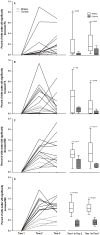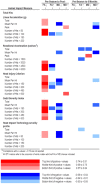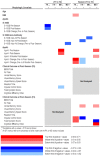Persistent, long-term cerebral white matter changes after sports-related repetitive head impacts
- PMID: 24740265
- PMCID: PMC3989251
- DOI: 10.1371/journal.pone.0094734
Persistent, long-term cerebral white matter changes after sports-related repetitive head impacts
Abstract
Introduction: Repetitive head impacts (RHI) sustained in contact sports are thought to be necessary for the long-term development of chronic traumatic encephalopathy (CTE). Our objectives were to: 1) characterize the magnitude and persistence of RHI-induced white matter (WM) changes; 2) determine their relationship to kinematic measures of RHI; and 3) explore their clinical relevance.
Methods: Prospective, observational study of 10 Division III college football players and 5 non-athlete controls during the 2011-12 season. All subjects underwent diffusion tensor imaging (DTI), physiologic, cognitive, and balance testing at pre-season (Time 1), post-season (Time 2), and after 6-months of no-contact rest (Time 3). Head impact measures were recorded using helmet-mounted accelerometers. The percentage of whole-brain WM voxels with significant changes in fractional anisotropy (FA) and mean diffusivity (MD) from Time 1 to 2, and Time 1 to 3 was determined for each subject and correlated to head impacts and clinical measures.
Results: Total head impacts for the season ranged from 431-1,850. No athlete suffered a clinically evident concussion. Compared to controls, athletes experienced greater changes in FA and MD from Time 1 to 2 as well as Time 1 to 3; most differences at Time 2 persisted to Time 3. Among athletes, the percentage of voxels with decreased FA from Time 1 to 2 was positively correlated with several helmet impact measures. The persistence of WM changes from Time 1 to 3 was also associated with changes in serum ApoA1 and S100B autoantibodies. WM changes were not consistently associated with cognition or balance.
Conclusions: A single football season of RHIs without clinically-evident concussion resulted in WM changes that correlated with multiple helmet impact measures and persisted following 6 months of no-contact rest. This lack of WM recovery could potentially contribute to cumulative WM changes with subsequent RHI exposures.
Conflict of interest statement
Figures





Similar articles
-
Novel Method of Weighting Cumulative Helmet Impacts Improves Correlation with Brain White Matter Changes After One Football Season of Sub-concussive Head Blows.Ann Biomed Eng. 2016 Dec;44(12):3679-3692. doi: 10.1007/s10439-016-1680-9. Epub 2016 Jun 27. Ann Biomed Eng. 2016. PMID: 27350072 Clinical Trial.
-
White matter alterations in college football players: a longitudinal diffusion tensor imaging study.Brain Imaging Behav. 2018 Feb;12(1):44-53. doi: 10.1007/s11682-017-9672-4. Brain Imaging Behav. 2018. PMID: 28092023
-
DTI Detection of Longitudinal WM Abnormalities Due to Accumulated Head Impacts.Dev Neuropsychol. 2015;40(2):92-7. doi: 10.1080/87565641.2015.1020945. Dev Neuropsychol. 2015. PMID: 25961592
-
Diffusion Tensor Imaging in Athletes Sustaining Repetitive Head Impacts: A Systematic Review of Prospective Studies.J Neurotrauma. 2019 Oct 15;36(20):2831-2849. doi: 10.1089/neu.2019.6398. Epub 2019 Jun 27. J Neurotrauma. 2019. PMID: 31062655
-
Long-Term Cognitive and Neuropsychiatric Consequences of Repetitive Concussion and Head-Impact Exposure.J Athl Train. 2017 Mar;52(3):309-317. doi: 10.4085/1062-6050-52.1.14. J Athl Train. 2017. PMID: 28387556 Free PMC article. Review.
Cited by
-
The Effects of External Jugular Compression Applied during Head Impact Exposure on Longitudinal Changes in Brain Neuroanatomical and Neurophysiological Biomarkers: A Preliminary Investigation.Front Neurol. 2016 Jun 6;7:74. doi: 10.3389/fneur.2016.00074. eCollection 2016. Front Neurol. 2016. PMID: 27375546 Free PMC article.
-
The neuropathology of chronic traumatic encephalopathy.Brain Pathol. 2015 May;25(3):350-64. doi: 10.1111/bpa.12248. Brain Pathol. 2015. PMID: 25904048 Free PMC article. Review.
-
Normalized Brain Tissue-Level Evaluation of Volumetric Changes of Youth Athletes Participating in Collision Sports.Neurotrauma Rep. 2022 Jan 28;3(1):57-69. doi: 10.1089/neur.2021.0060. eCollection 2022. Neurotrauma Rep. 2022. PMID: 35112108 Free PMC article.
-
White matter hyperintensities in former American football players.Alzheimers Dement. 2023 Apr;19(4):1260-1273. doi: 10.1002/alz.12779. Epub 2022 Aug 22. Alzheimers Dement. 2023. PMID: 35996231 Free PMC article.
-
Microstructural Alterations in Tract Development in College Football and Volleyball Players: A Longitudinal Diffusion MRI Study.Neurology. 2023 Aug 29;101(9):e953-e965. doi: 10.1212/WNL.0000000000207543. Epub 2023 Jul 21. Neurology. 2023. PMID: 37479529 Free PMC article.
References
-
- Langlois JA, Rutland-Brown W, Wald MM (2006) The epidemiology and impact of traumatic brain injury: a brief overview. Journal of Head Trauma Rehabilitation 21: 375–378. - PubMed
-
- Marar M, McIlvain N, Fields S, Comstock D (2012) Epidemiology of Concussions Among United States High School Athletes in 20 Sports. The American Journal of Sports Medicine 40: 747–755. - PubMed
Publication types
MeSH terms
Grants and funding
LinkOut - more resources
Full Text Sources
Other Literature Sources
Medical
Miscellaneous

